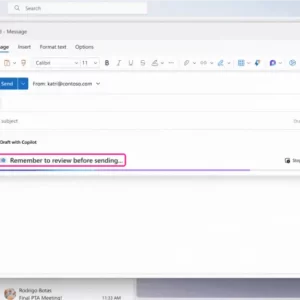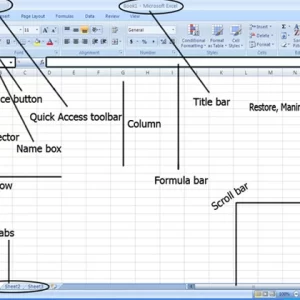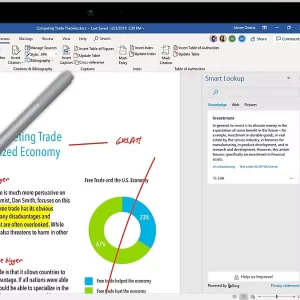Course Description:
Your training and experience using Microsoft® Office Access® has given you basic database management skills, such as creating tables, designing forms and reports, and building queries. In this course, you will expand your knowledge of relational database design; promote quality input from users; improve database efficiency and promote data integrity; and implement advanced features in tables, queries, forms, and reports. Extending your knowledge of Access will result in a robust, functional database for your users.
This course is the second part of a three-course series that covers the skills needed to perform database design and development in Access 2019.
- Microsoft® Office Access® 2019: Part 1 : Focuses on the design and construction of an Access database —viewing, navigating, searching, and entering data in a database, as well as basic relational database design and creating simple tables, queries, forms, and reports.
- Microsoft® Office Access® 2019: Part 2 (this course): Focuses on optimization of an Access database, including optimizing performance and normalizing data; data validation; usability; and advanced queries, forms, and reports.
- Microsoft® Office Access® 2019: Part 3 : Focuses on managing the database and supporting complex database designs , including import and export of data; using action queries to manage data; creating complex forms and reports; macros and Visual Basic for Applications (VBA); and tools and strategies to manage, distribute, and secure a database.
This course covers Microsoft Office Specialist Program exam objectives to help you prepare for the Access Expert (Office 363 and Office 2019): Exam MO-500 certification.
Course Topics
Lesson 1: Promoting Quality Data Input
Topic A: Restrict Data Input Through Field Validation
Topic B: Restrict Data Input Through Forms and Record Validation
Lesson 2: Improving Efficiency and Data Integrity
Topic A: Data Normalization
Topic B: Associate Unrelated Tables
Topic C: Enforce Referential Integrity
Lesson 3: Improving Table Usability
Topic A: Create Lookups Within a Table
Topic B: Work with Subdatasheets
Lesson 4: Creating Advanced Queries
Topic A: Create Query Joins
Topic B: Create Subqueries
Topic C: Summarize Data
Lesson 5: Improving Form Presentation
Topic A: Apply Conditional Formatting
Topic B: Create Tab Pages with Subforms and Other Controls
Lesson 6: Creating Advanced Reports
Topic A: Apply Advanced Formatting to a Report
Topic B: Add a Calculated Field to a Report
Topic C: Control Pagination and Print Quality
Topic D: Add a Chart to a Report
Appendix A: Mapping Course Content to Access Expert (Office 365 and Office 2019): Exam MO-500
Appendix B: Microsoft® Office Access® 2019 Common Keyboard Shortcuts
Course Objectives
In this course, you will optimize an Access 2019 database.
You will:
- Provide input validation features to promote the entry of quality data into a database.
- Organize a database for efficiency and performance, and to maintain data integrity.
- Improve the usability of Access tables.
- Create advanced queries to join and summarize data.
- Use advanced formatting and controls to improve form presentation.
- Use advanced formatting and calculated fields to improve reports.
Target Audience
This course is designed for students wishing to gain intermediate-level skills or individuals whose job responsibilities include constructing relational databases and developing tables, queries, forms, and reports in Microsoft Office Access 2019.
Hardware
For this course, you will need one computer for each student and one for the instructor. Each computer will need the following minimum hardware configurations:
- 1.6 GHz or faster 32-bit (x86) or 64-bit (x64) multi-core processor
- 4 gigabyte (GB) RAM (64-bit) or 2 GB RAM (32-bit)
- 20 GB available hard disk space (64-bit) or 16 GB (32-bit)
- Keyboard and mouse (or other pointing device)
- 1280 × 1024 or higher resolution monitor recommended
- Network cards and cabling for local network access
- Internet access (contact your local network administrator)
- Printer (optional) or an installed printer driver
- Projection system to display the instructor’s computer screen
Prerequisites
To ensure your success in this course, it is recommended you have completed Microsoft® Office Access® 2019: Part 1 or possess equivalent knowledge.
It is also suggested that you have end-user skills with any current version of Windows, including being able to start programs, switch between programs, locate saved files, close programs, and use a browser to access websites. You can obtain this level of skills and knowledge by taking either of the following Logical Operations courses, or any similar courses in general Microsoft Windows skills:
- Using Microsoft® Windows® 10
- Microsoft® Windows® 10: Transition from Windows® 7
Inclusions
With CCS Learning Academy, you’ll receive:
- 2 Day Certified Instructor-led training
- Official Training Seminar Student Handbook
- Collaboration with classmates (not currently available for self-paced course)
- Real-world learning activities and scenarios
- Exam scheduling support*
- Enjoy job placement assistance for the first 12 months after course completion.
- This course is eligible for CCS Learning Academy’s Learn and Earn Program: get a tuition fee refund of up to 50% if you are placed in a job through CCS Global Tech’s Placement Division*
- Government and Private pricing available.*
*For more details call: 858-208-4141 or email: training@ccslearningacademy.com; sales@ccslearningacademy.com






